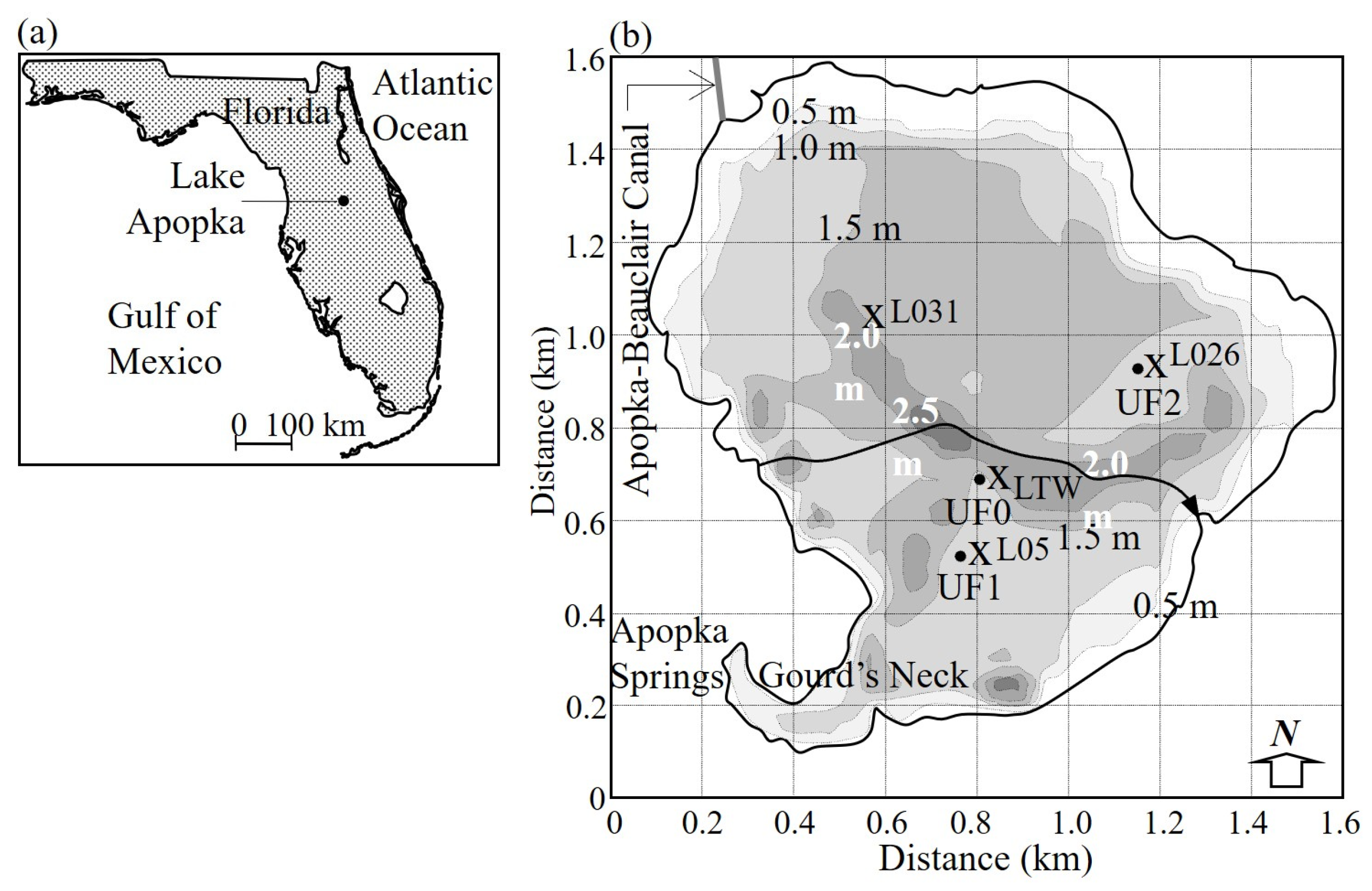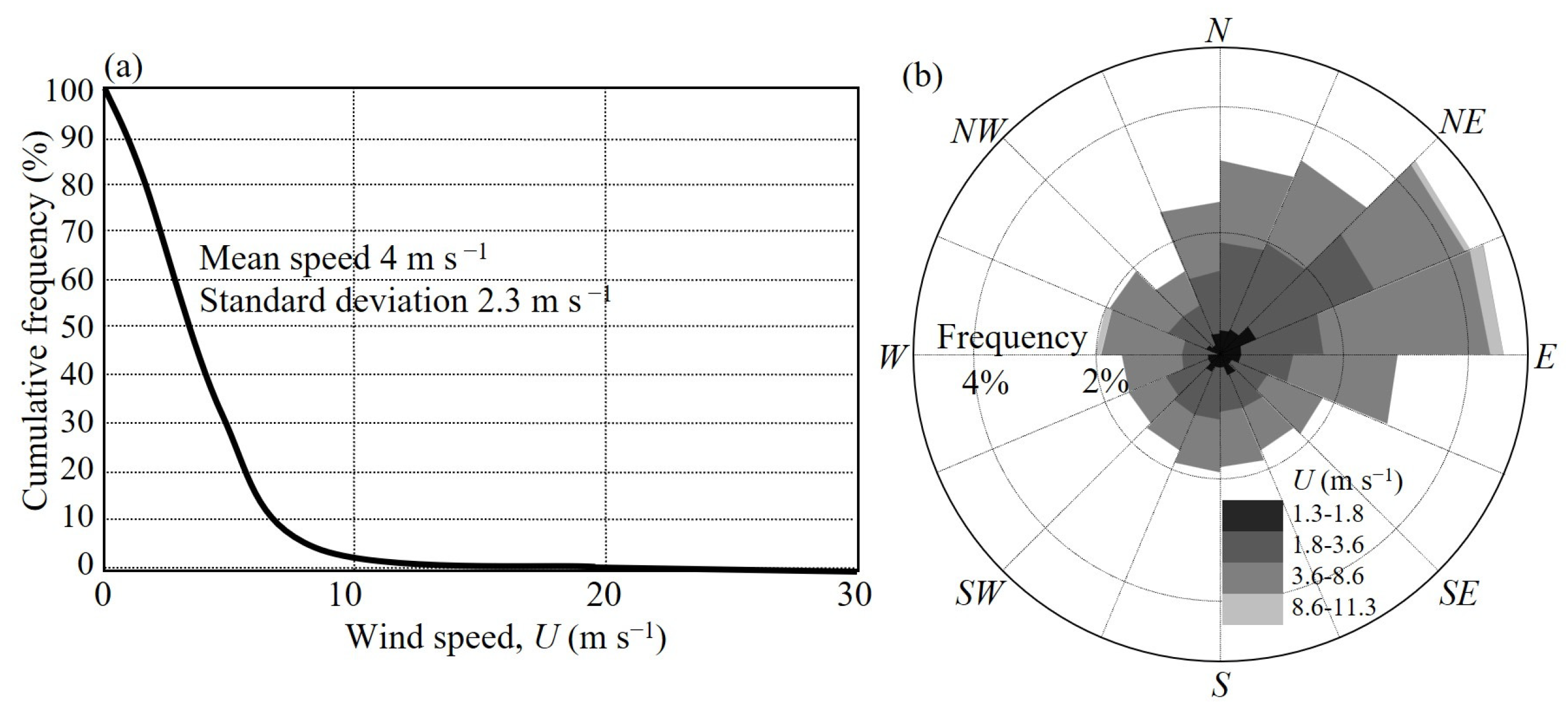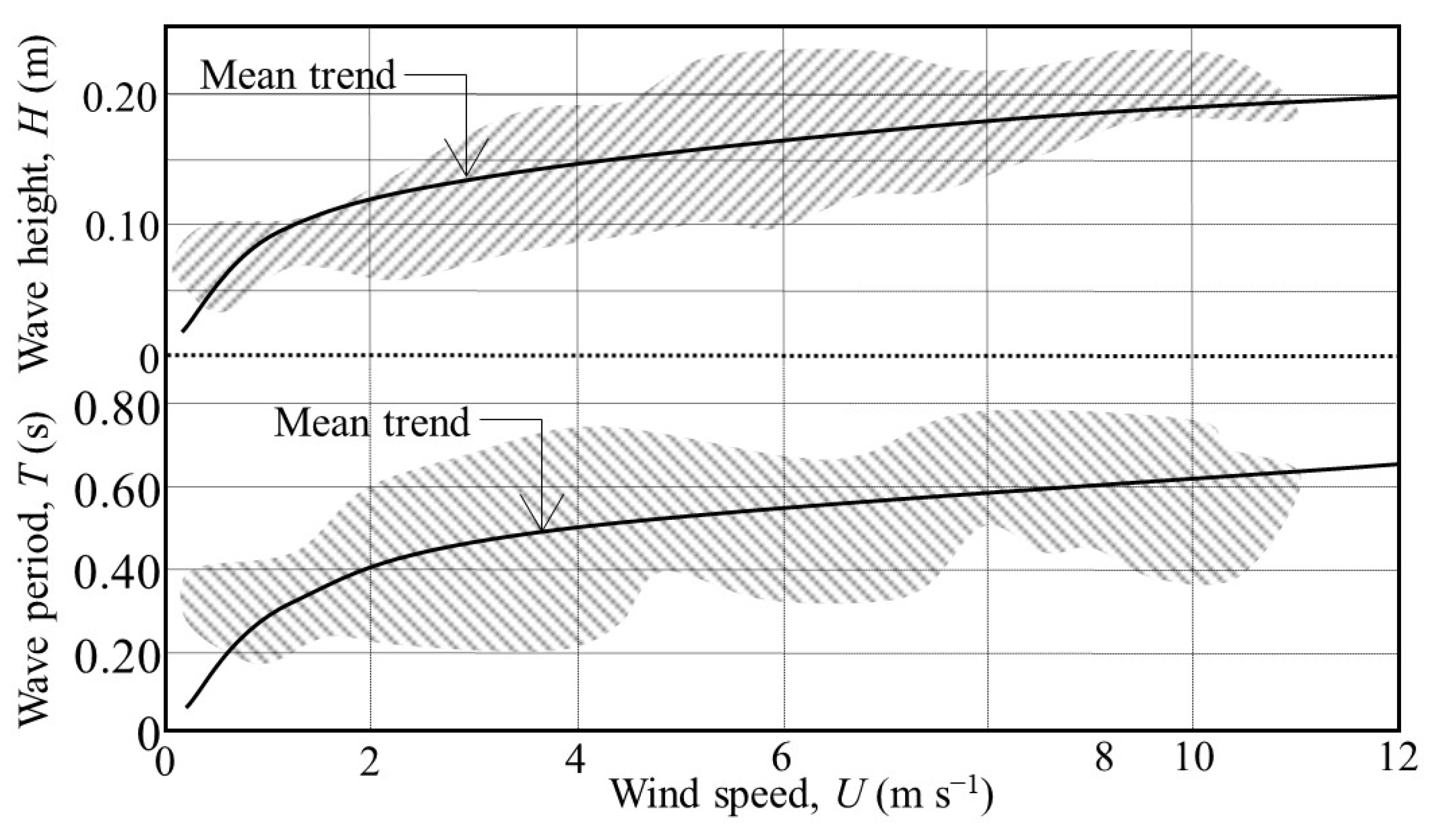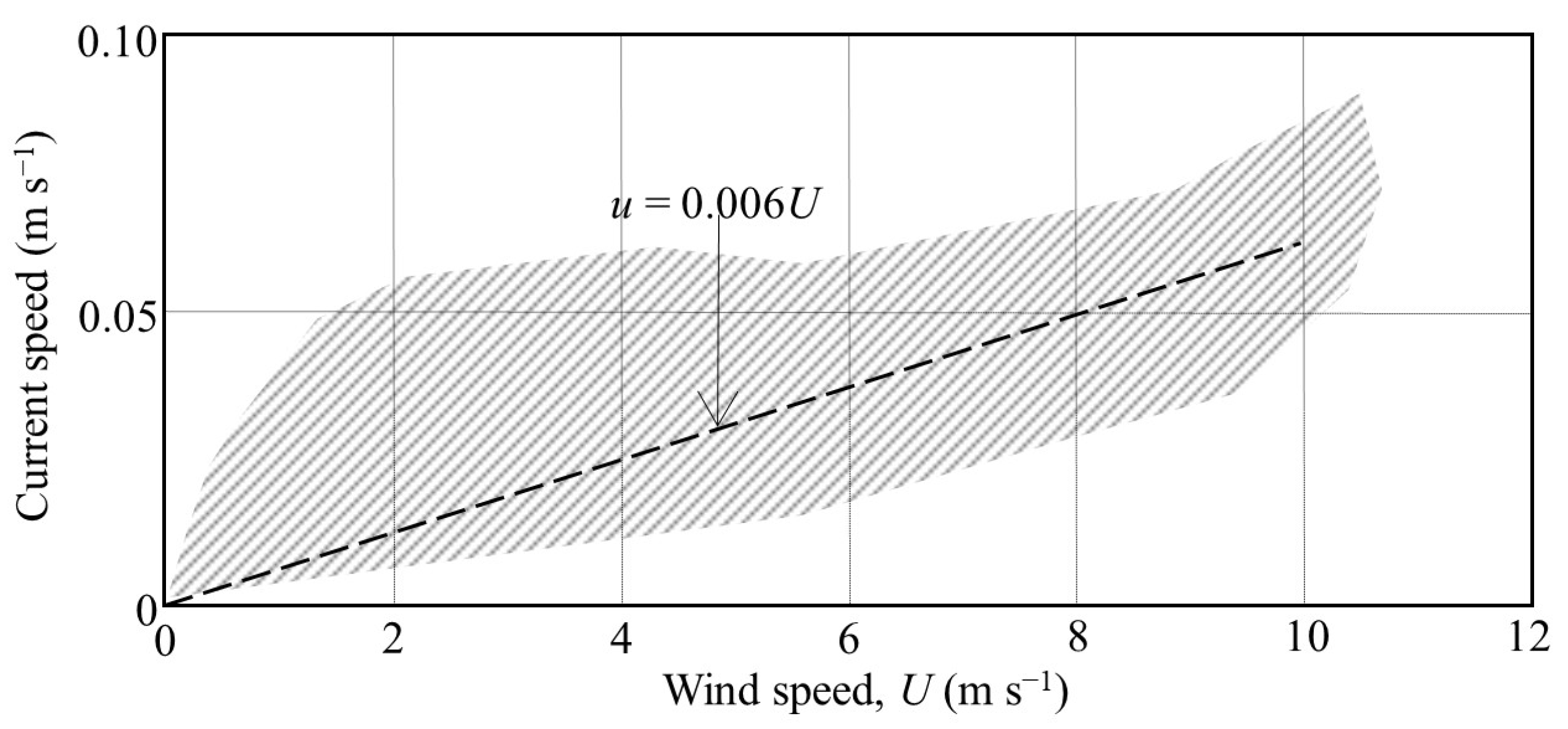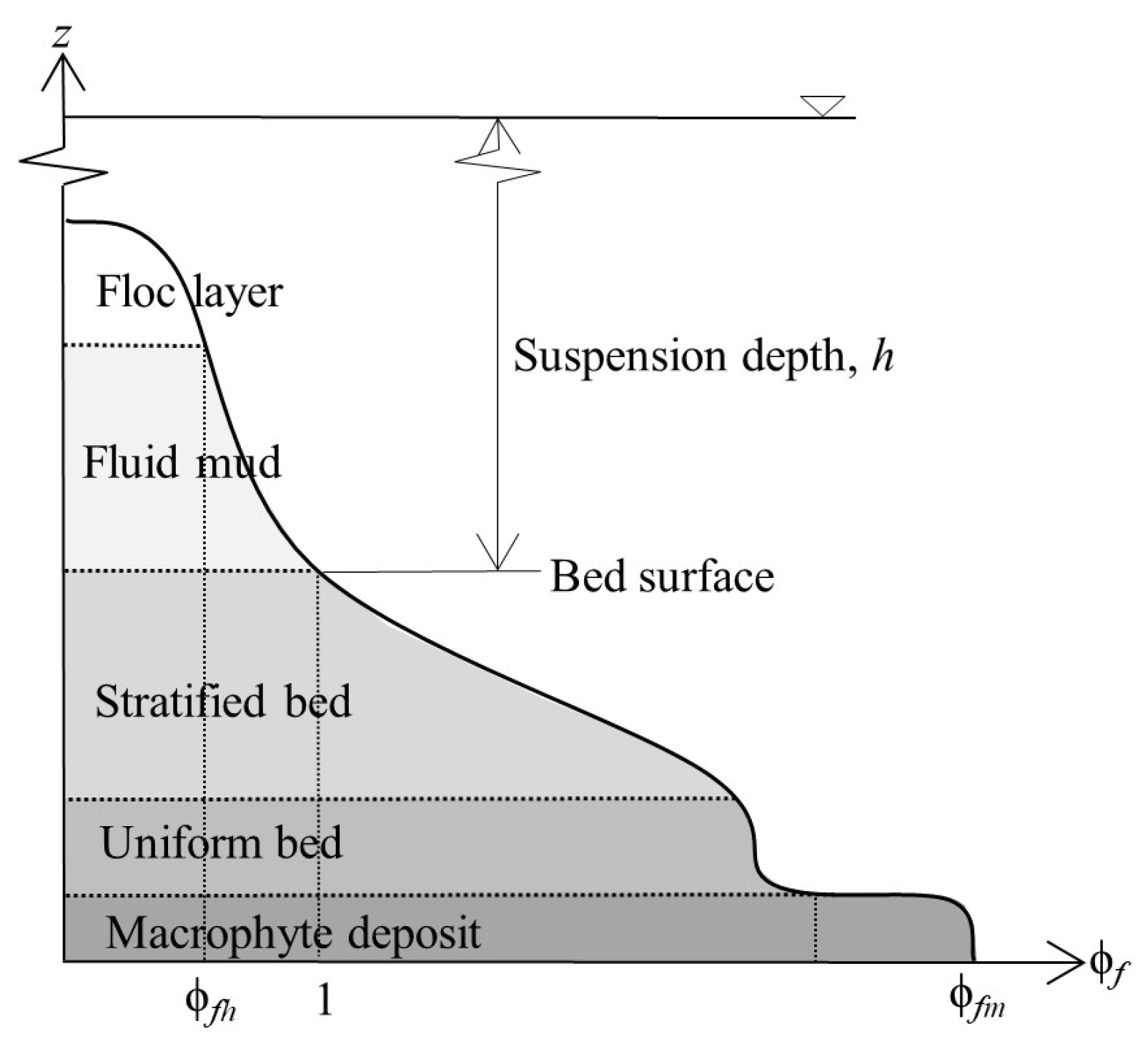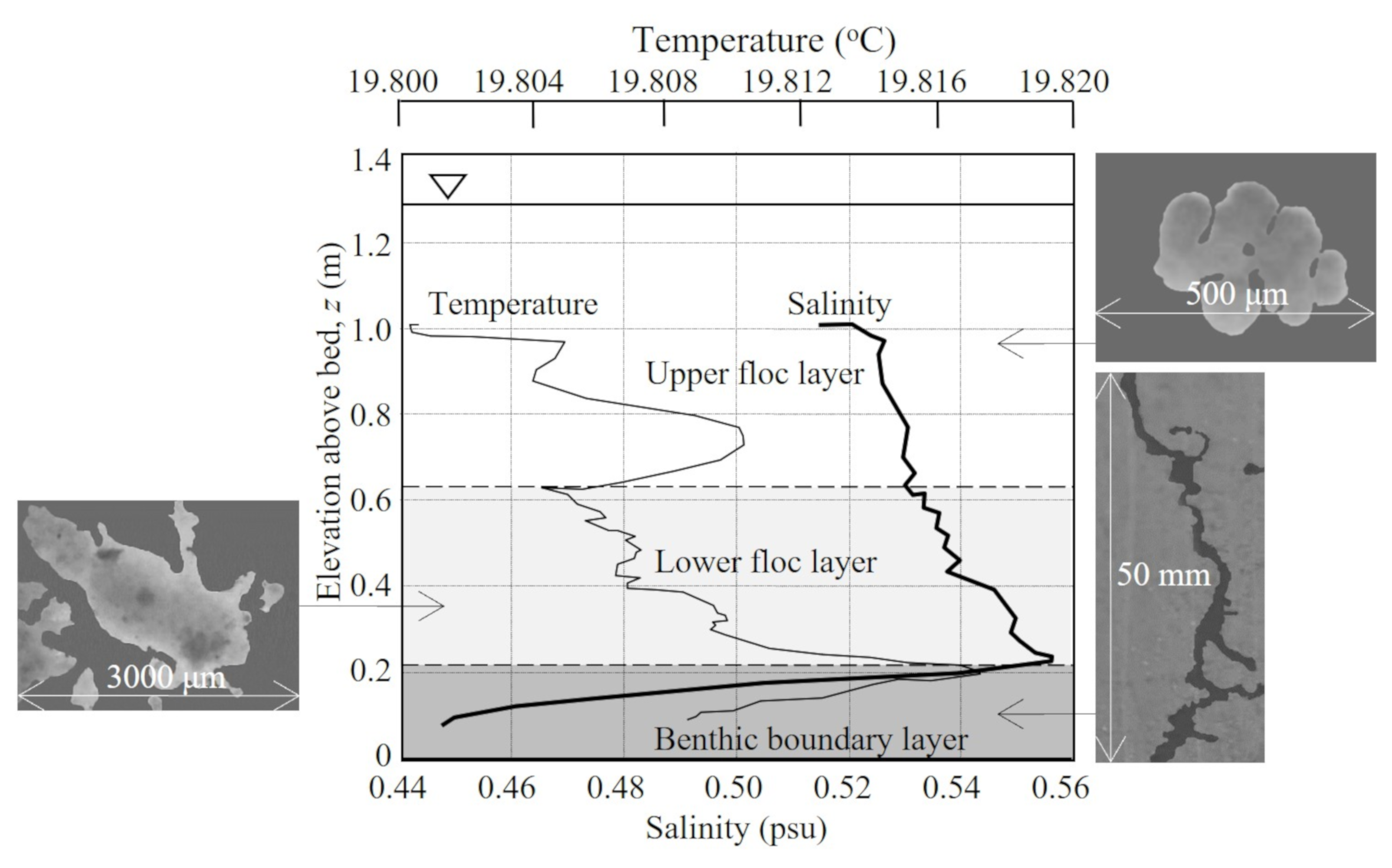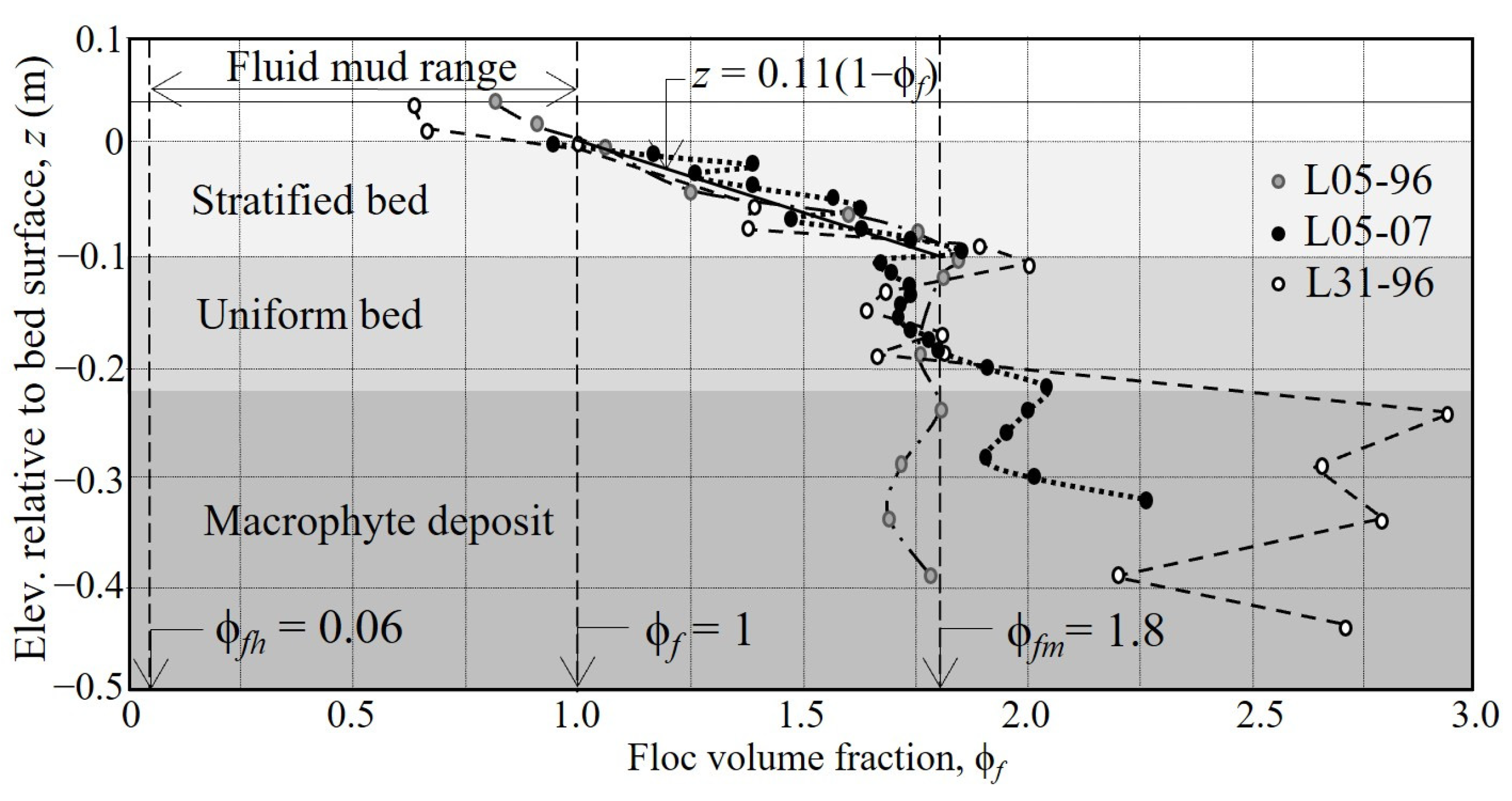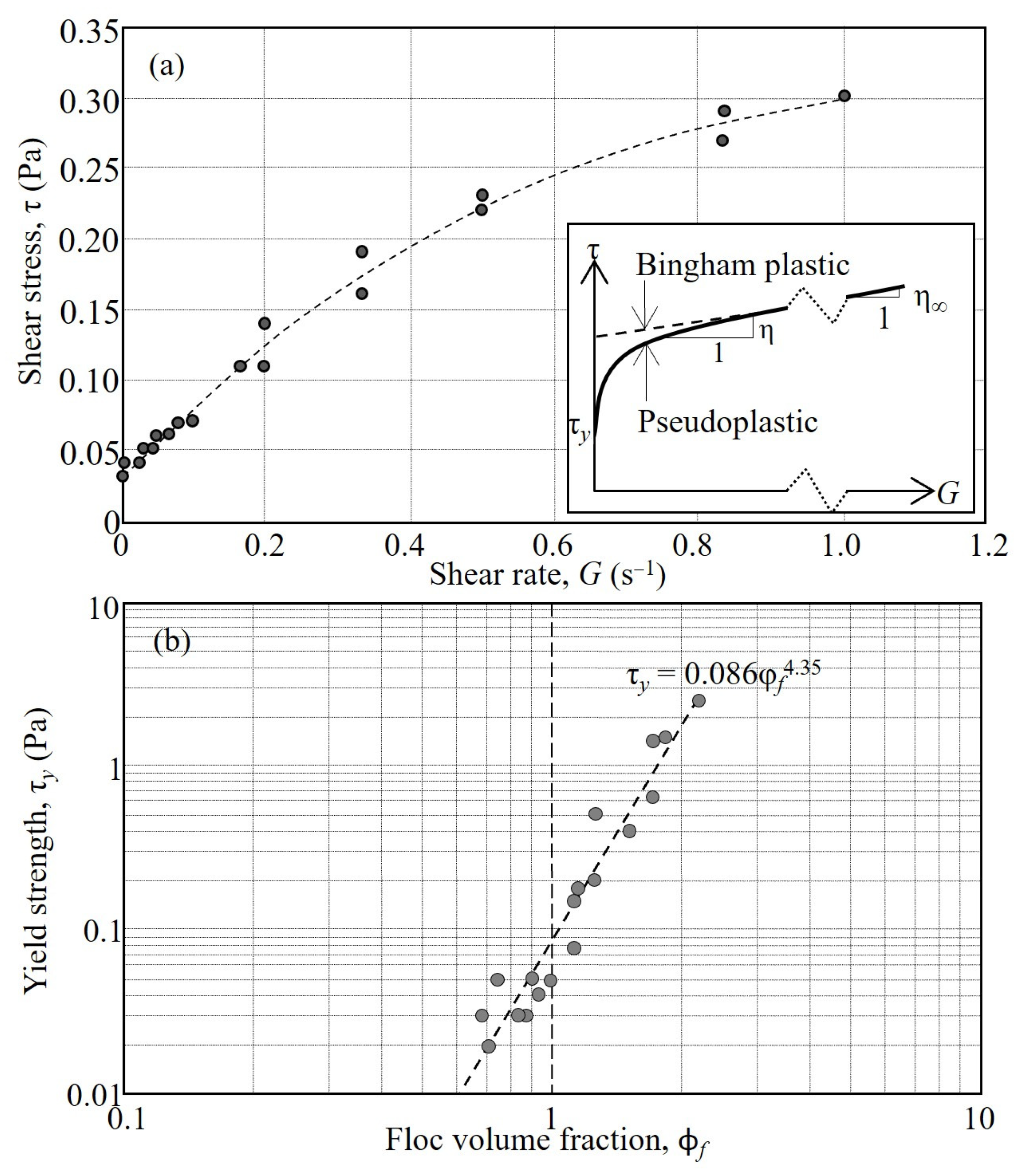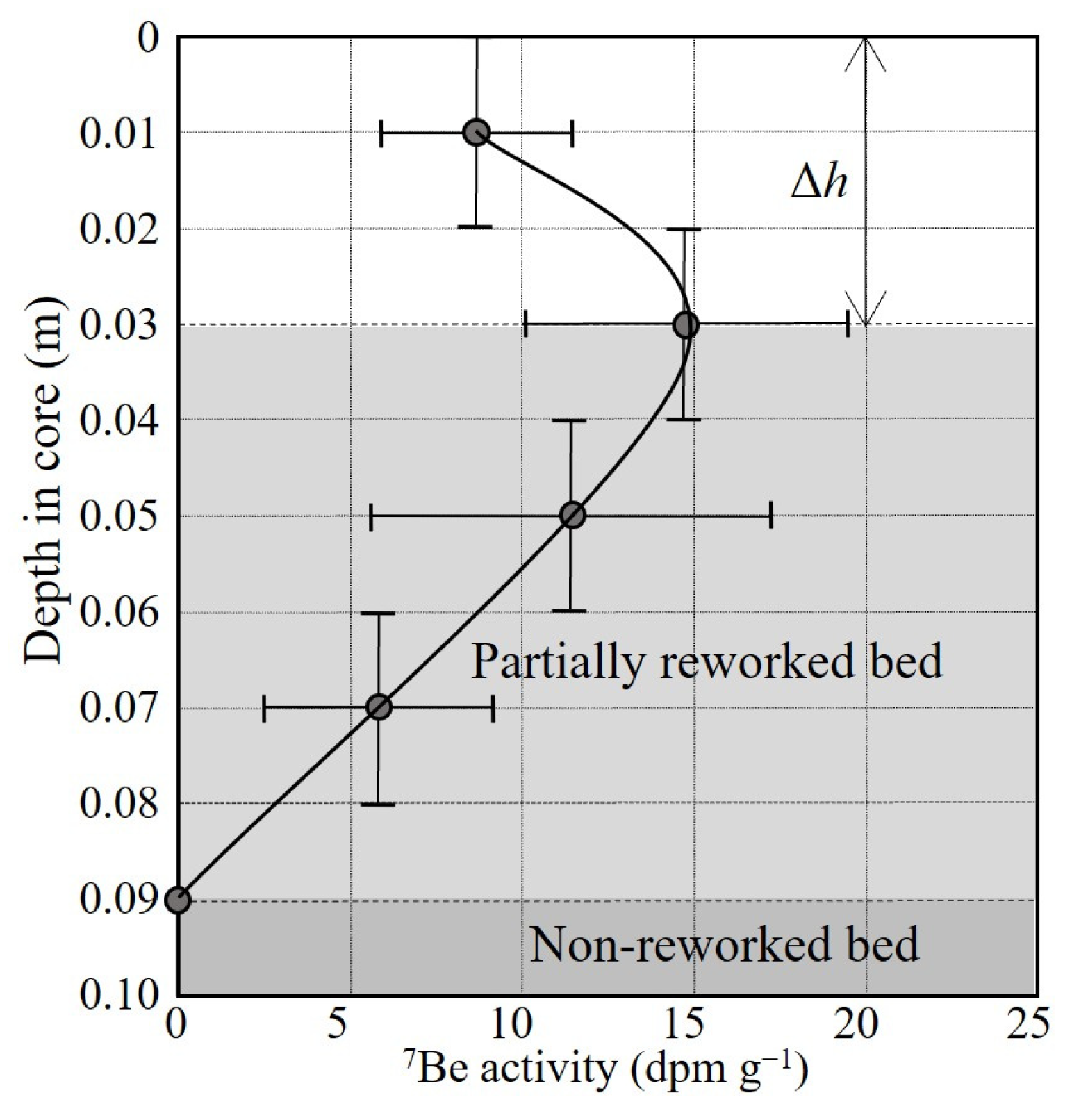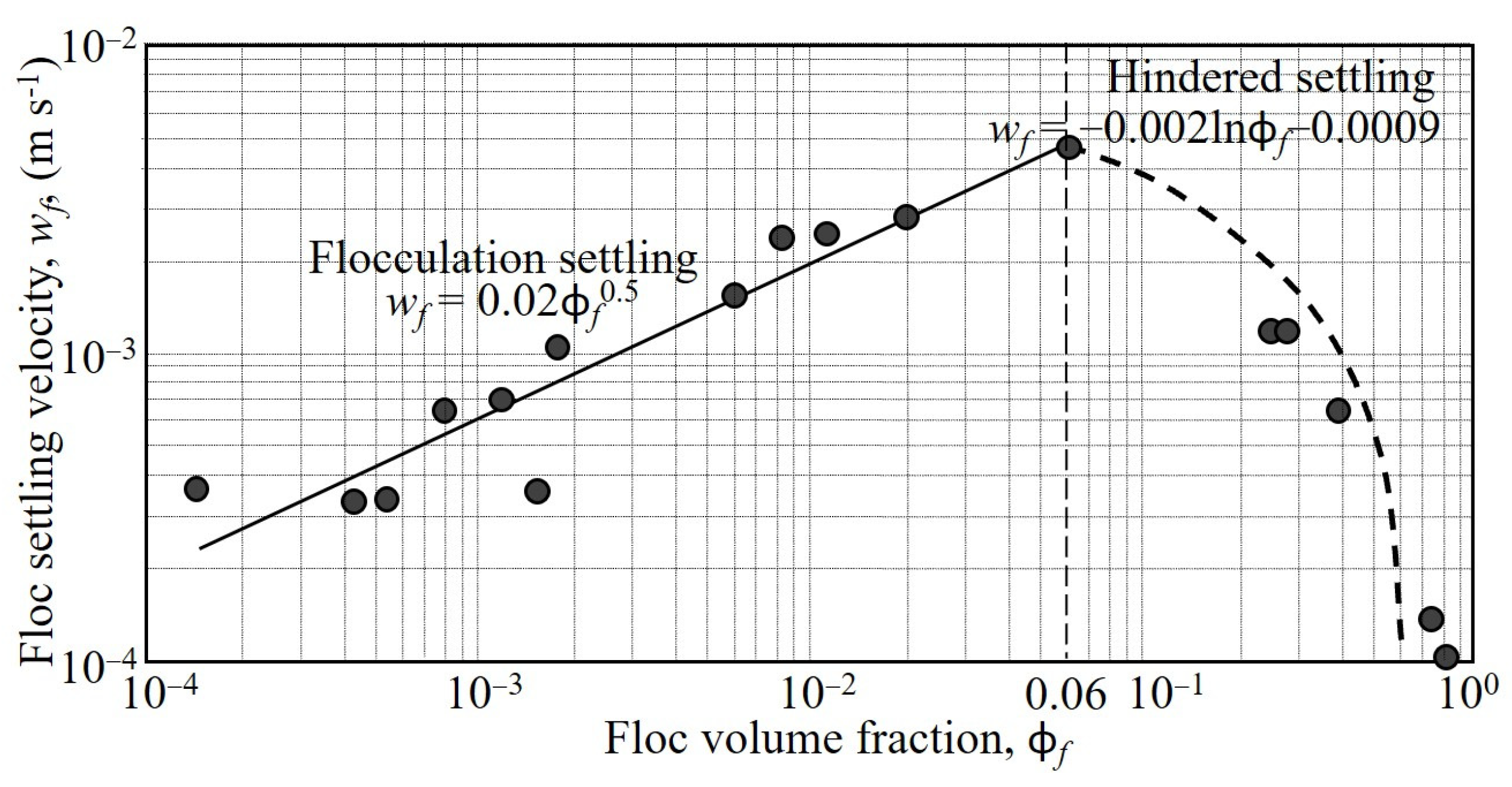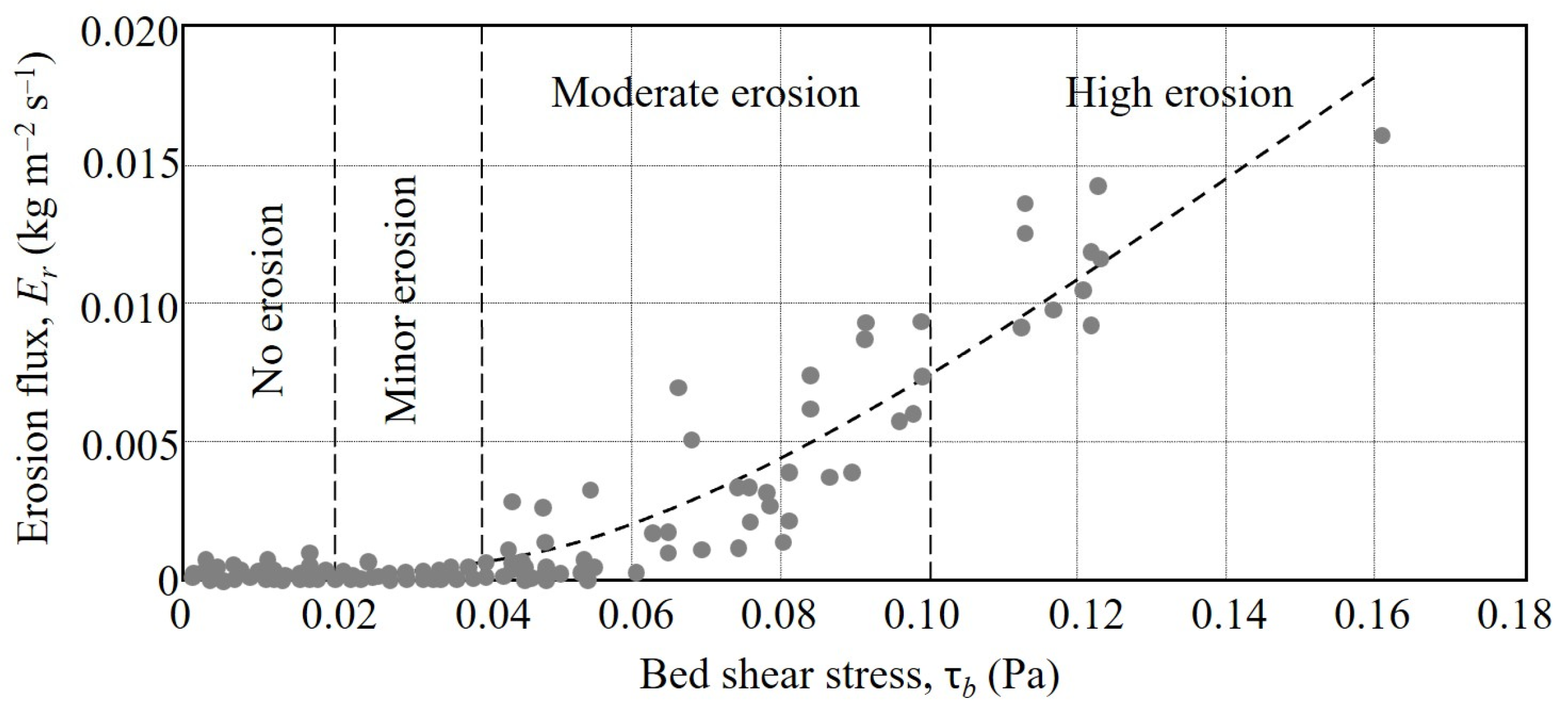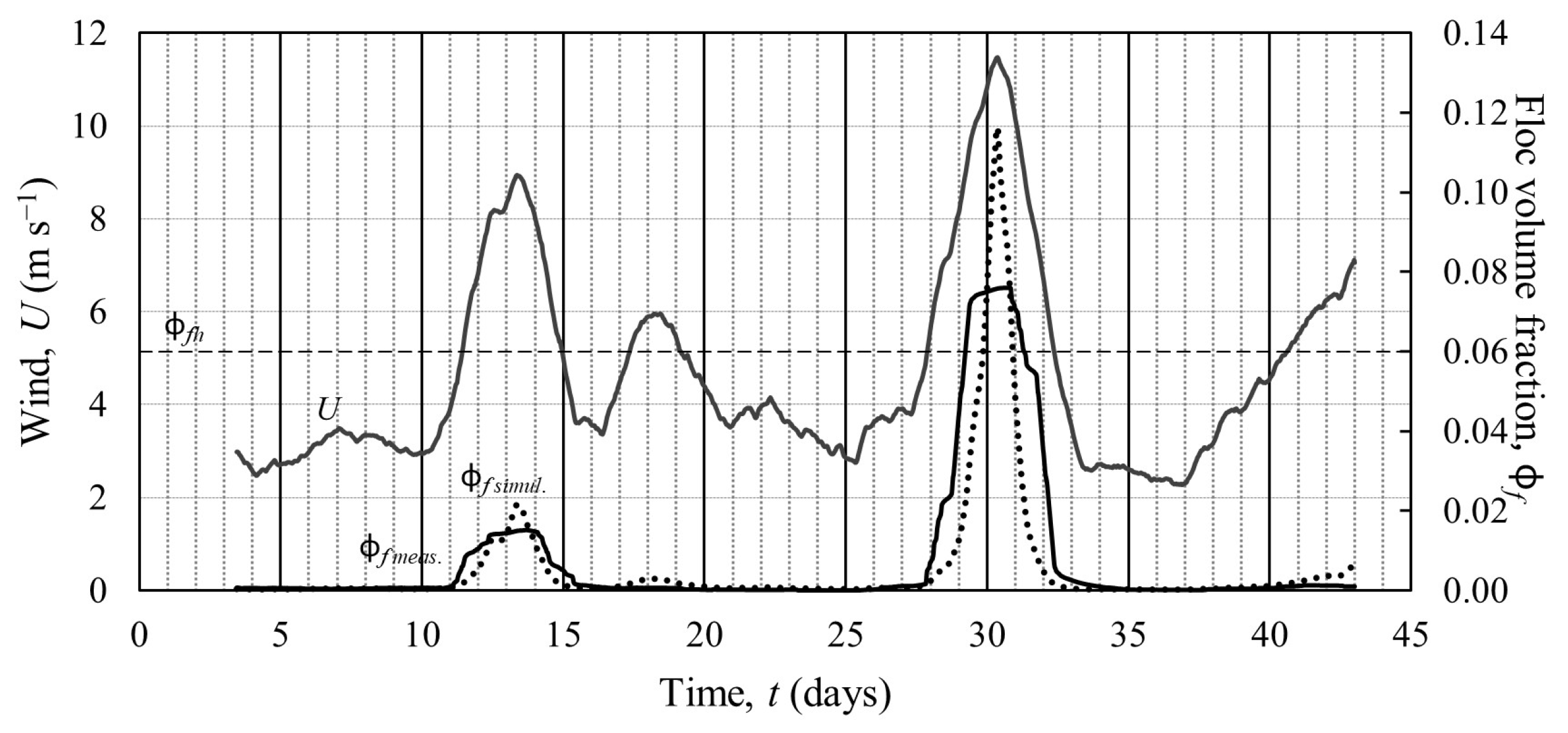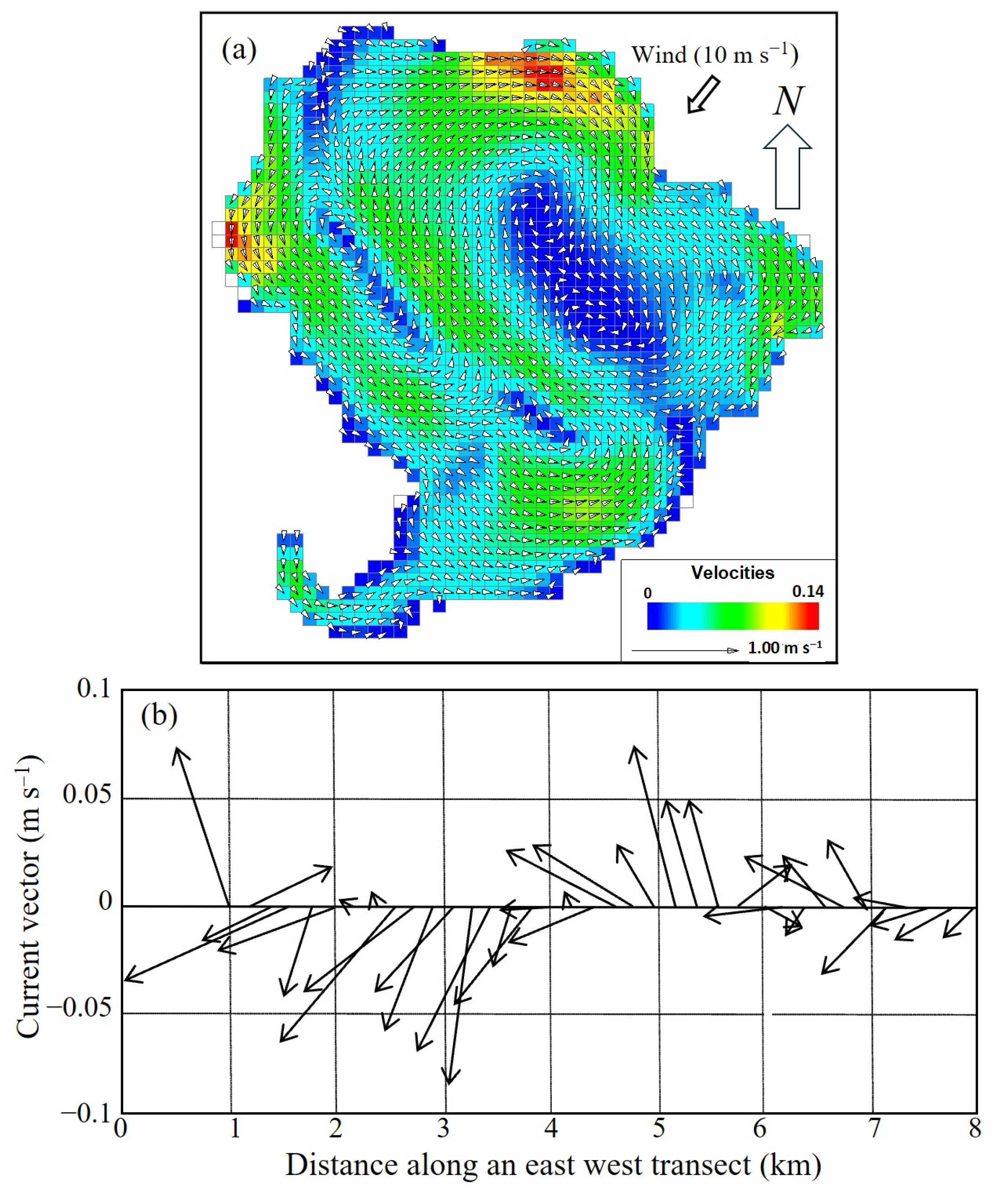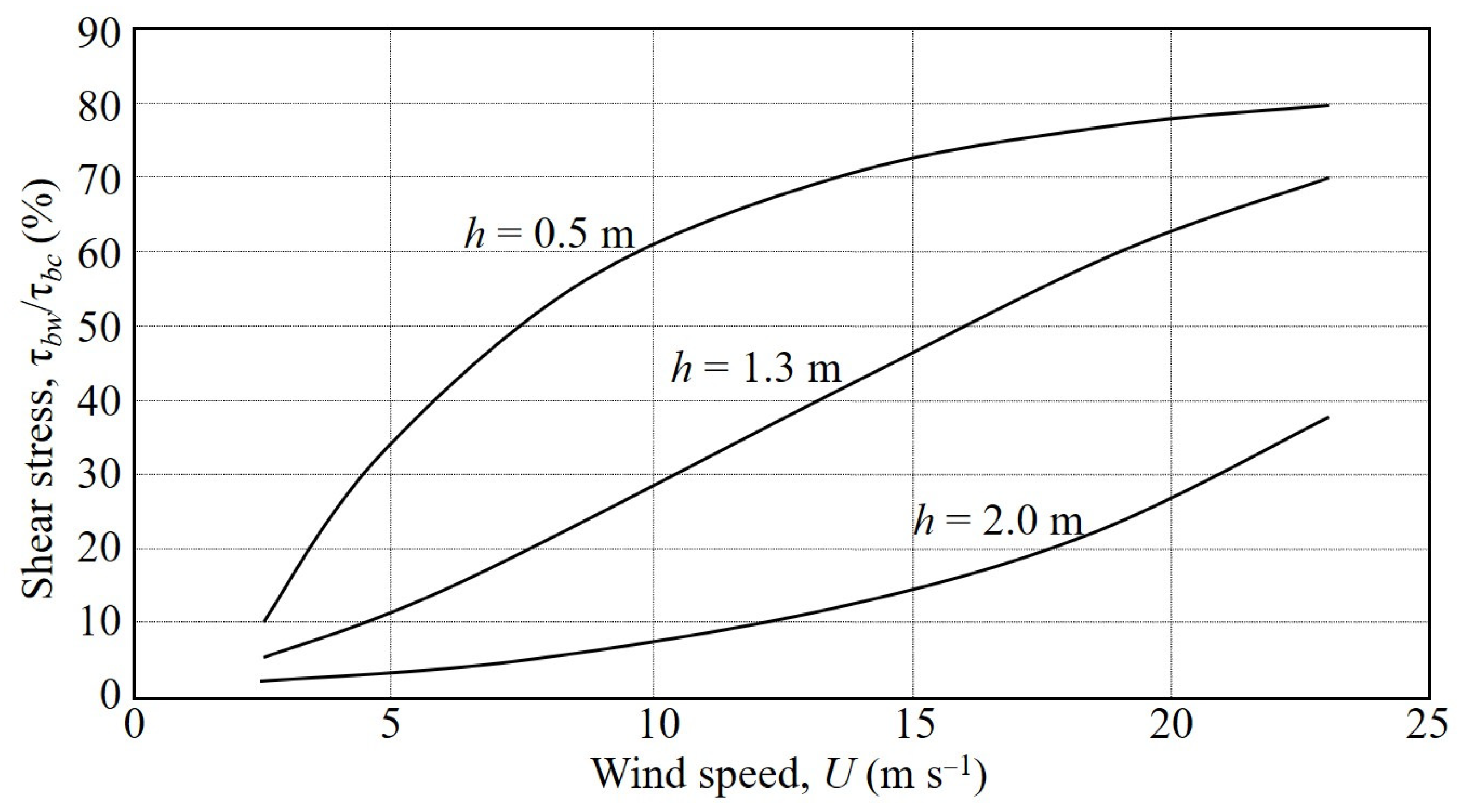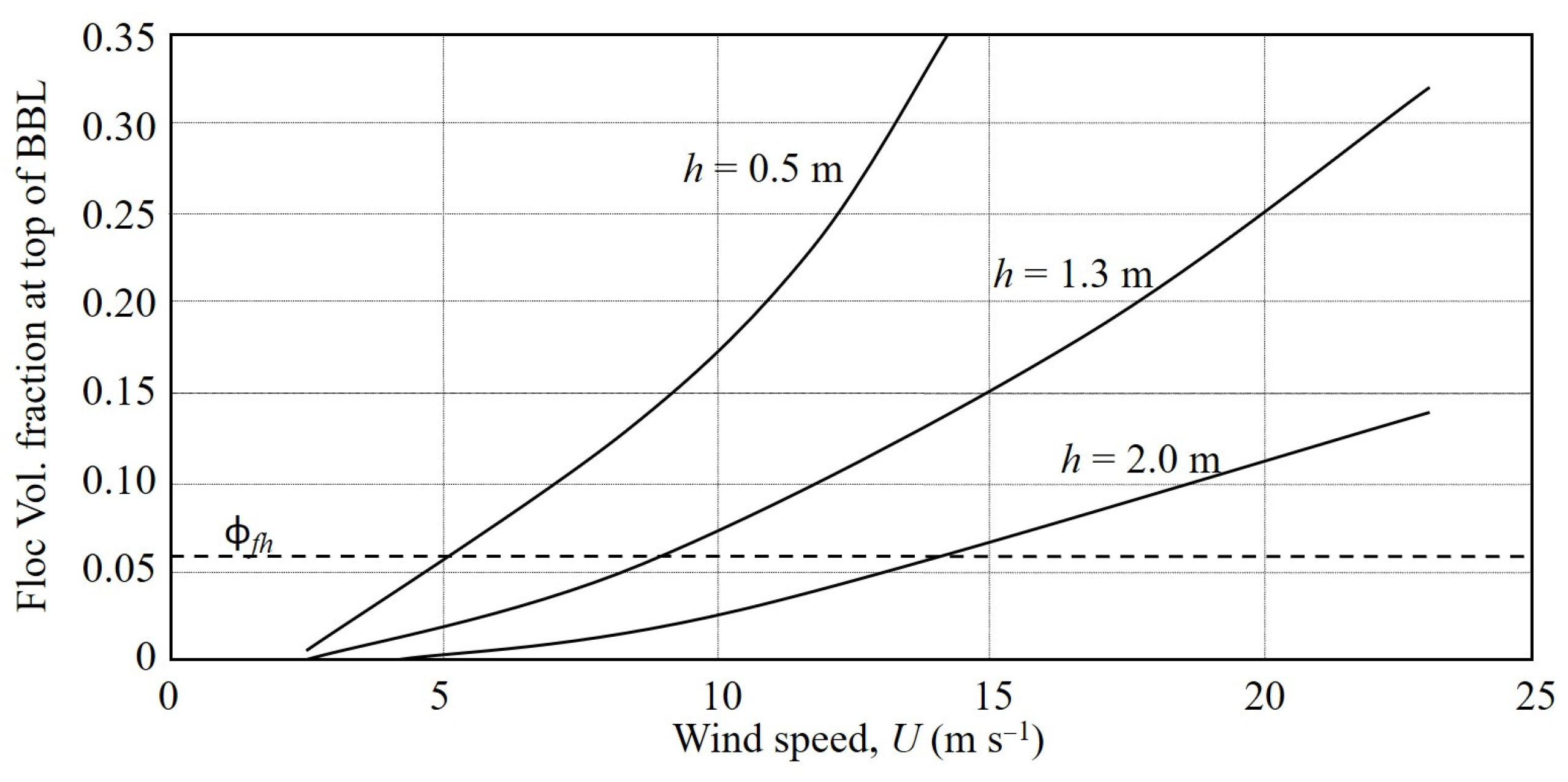1. Introduction
In shallow lakes with organic-rich cohesive sediment, resuspension of flocs is due to wind-induced waves and currents. Thus, nutrients and contaminants, if sequestered in the bottom sediment, may contribute to algal blooms, growth of macrophytes, and high toxicity [
1,
2,
3]. In Lake Apopka, about ~25 km northwest of the Orlando metropolitan area in Florida (28°37′8.39″ N, −81°37′11.39″ W;
Figure 1a,b), the emergence of phosphate associated with resuspended flocs has been a persistent concern due to high concentrations of total phosphorus in the bottom sediment. Phosphate accumulation is believed to have resulted mainly due to discharges from a large farming area on a floodplain marsh north of the lake [
4]. As a result, the bottom mud over an originally sandy substrate has increased in thickness to as much as 2 m.
From the viewpoint of sediment movement in the lake, of particular interest is the occurrence of fluid mud confirmed in a study of the bottom sediment [
5]. In that regard, as it contributes most of the suspended sediment mass, decreasing the effect of wind by increasing the water depth is one way by which mud in this form can be contained. However, as no study of sediment dynamics had been made in the lake, questions concerning the required minimum water depth were unaddressed. The aim of the present investigation was to ascertain the dependence of fluid mud height and frequency on wind speed and water depth. The study relied on a field measurement campaign, laboratory tests to characterize the sediment properties, and the use of a numerical hydrodynamic/sediment transport model for predictive purposes.
This presentation includes the following: (1) methods used for the field investigation and hydrodynamic modeling; (2) the lake’s physical setting including wind, waves, and currents; (3) sediment properties; (4) simulations of lake hydrodynamics and fluid mud rise as functions of wind speed and mean water depth; and (5) observations on the required water depth to contain fluid mud rise. The full study is reported in [
6]. For the present work, the analyses of both field and laboratory measurements including modeling were partially re-evaluated. Moreover, the work focusses on lake-specific relationships between the wind speed, water depth, and the probability of occurrence of fluid mud. The investigation generally follows a framework for such studies in estuaries, bays, and lakes proposed by [
7].
3. Wind, Waves, and Currents
The distribution (percent) of wind speed
U in
Figure 2a is based on measurements at the tower (UF0) during the years 2002 to 2007. The mean speed was 4 m s
−1 with a standard deviation of 2.3 m s
−1. High winds were infrequent; the speed reached 30 m s
−1 only eleven times during those six years, which would mean a frequency of about two per year. An uncommon high value of 54 m s
−1 occurred in 2004 during the passage of Hurricane Jeanne across Central Florida. The wind rise for 2007 in
Figure 2b indicates that northeasterly winds (in late fall and winter) are dominant. During the investigation, barring a single event when the wind reached 23 m s
−1, the maximum speed was less than 12 m s
−1, which made it essential to resort to modeling to estimate the SSC at higher winds.
Figure 3 shows measurements (hatched areas) of the significant wave height
H and period
T. Although the typical wind direction was northeasterly, fluctuations in wind speed and duration (hence fetch) expectedly resulted in the observed data spread. Notwithstanding this limitation, the equation-based mean trends for wave height and wave period characteristically rise linearly in the low wind range, followed by decreasing rates of rise at higher winds [
13].
Figure 4 plots a 27-day (starting January 2008) water level record and model simulation at UF0. Agreement is attested by the low error range of ±0.35% with a mean of 0.014%. The mean level was 19.4 m above the NAVD88 datum, which is equivalent to a mean water depth of 1.3 m. Low frequency (~2 × 10
−6 Hz) frontal oscillations are significant, with the largest amplitude of 0.15 m amounting to ~12% of mean water depth.
Figure 5 shows the measured current vector
u at the top of the BBL at 0.2 m elevation against wind speed. Temporal fluctuations in wind speed and direction, although generally aligned with the mean wave direction, are believed to be the cause of the data spread (hatched area). Dashed curve represents the model simulated mean trend. From simulations, the current at the surface
us was found to be an order of magnitude greater than at 0.2 m, i.e., the coefficient 0.006 (inset) increased to 0.06, which is consistent with
us resulting from wind-induced surface stress [
14].
5. Resuspension Dynamics
During a high-wind episode, fluid mud occurs in the BBL when the bed sediment erodes and rises upward by turbulent diffusion and at the end of the episode when the suspension begins to settle relatively rapidly at the onset and stacks up above the bed as fluid mud, which then settles slowly. The timescales for both erosion and settling in Lake Apopka are the order of an hour. Presently, we will focus attention on the rising phase of the fluid mud, with significant fluid mud considered to occur when its height ΔhF reaches the top of BBL (at 0.2 m) as ϕf increases to ϕfh at that elevation. In this condition, ϕf below 0.2 m characteristically increases above ϕfh with depth.
For modeling erosion and settling, the deposition flux
Dr in the suspended sediment mass balance in each model grid cell is
where the floc settling velocity
wf is a function of ϕ
f and the shear rate
G. The bed surface erosion flux
Er is
where
f(τ
b, τ
e) denotes a function of the wave-current bed shear τ
b and the erosion threshold stress τ
e. The former was calculated from
where τ
bw and τ
bc are the wave- and current-induced bed shear stresses, respectively, and χ is a proportionality coefficient. At any grid cell defined by the local depth, to calculate τ
b from Equation (5) for a given wind speed and fetch, the wave height and the period at that cell were determined first. The stress τ
bw was obtained from the near-bed, linear-wave orbital velocity with a drag coefficient based on
ks = 0.065 m [
13]. The stress τ
bc was calculated from the model-simulated hydrostatic current velocity in the bottom-most layer, which includes inherent contributions from wind-induced water level setup in the lake, and χ was obtained from a method provided by [
19].
The settling velocity
wf was evaluated from on-site tests in a 1 m tall column using suspended sediment samples collected near UF0, and
wf at higher ϕ
f were obtained from a 1.85 m tall laboratory column [
20]. The plot of
wf against ϕ
f in
Figure 11 identifies ϕ
fh as 0.06 (3.26 kg m
−3), which is typical for organic-rich fine sediments but lower by about a half than clay mineral flocs [
10]. Due to the low currents under normal conditions in the lake, the roughness Reynolds number
Ref =
ks(ρ
wτ
b)
0.5/η
w is below 500, implying that both skin friction and form drag contribute to the turbulent energy loss. Given low
Ref and assuming that the role of shear rate
G is minor, data fits yield the approximate formulas for unhindered (flocculation) and hindered settling given in the inset in
Figure 11.
Due to inter-particle cohesive bonding in the stratified bed
SB manifested by the effective normal stress, bed compression from consolidation is characteristically slow compared to hindered settling. To confirm this, measurements of the falling sediment/water interface were made in the 1.85 m column, starting with an initial floc volume fraction ϕ
f0 = 1.07 (
C0 = 58.1 kg m
−3) and a deposit height of 0.45 m [
20]. It was observed that the time to decrease the height of the bed to 0.22 m (thus doubling the depth-mean ϕ
f) was about 17 h, i.e., a mean settling rate of 6.4 × 10
−8 m s
−1. Based on this duration relative to the hindered settling velocity on the order of 10
−4 m s
−1 (
Figure 11), consolidation was assumed negligible in modeling resuspension.
The variation of bed surface erosion flux
Er with τ
b in
Figure 12 is based on SSC measurements at UF0 augmented by available synchronous data from UF1 and UF2. The following polynomial equation [
21], whose basis is a stochastic treatment of erosion by the turbulent, time-dependent bed shear stress, was used to generate the mean trend
with τ
e = 0.02 Pa,
a1 = −190.03,
a2 = 83.57,
a3 = −2.99, and
a4 = −0.02. The curve generally represents the data up to τ
b = 0.12 Pa but is somewhat speculative at higher stresses due to the scarcity of measurements. Notwithstanding this constraint, the trend is conveniently divided into four zones—no erosion (τ
b < 0.02 Pa), minor erosion (0.02 Pa ≤ τ
b < 0.04 Pa), moderate erosion (0.04 Pa ≤ τ
b < 0.10 Pa), and high erosion (τ
b ≥ 0.10 Pa). The threshold 0.10 Pa coincides with the onset of bed weakening. However, as its effect on surface erosion cannot be readily quantified, Equation (6) is assumed to apply over the full range of τ
b.
6. Fluid Mud Dynamics
Figure 13 plots ϕ
f against wind speed at UF0 over a 41-day period beginning 9 December 2007. Two significant episodes separated by relatively calm weather over about ten days have been captured, although, typically, the maximum wind remained less than 12 m s
−1. The measured floc volume fraction ϕ
fmeas is generally synchronous with the wind, having a correlation coefficient of 0.78. The inference would be that wave-induced local erosion and deposition, as opposed to weak current-induced advection, largely govern the variation of SSC. This is supported by the simulated floc volume fraction ϕ
fsimul, which correlates well with the wind (correlation coefficient of 0.91). Moreover, ϕ
fmeas and ϕ
fsimul indicate a correlation coefficient of 0.86 and a reasonably low mean error of 26%. Observe that fluid mud rose to the height of the BBL just once, on days 29–30, when the wind peaked at 11.6 m s
−1.
To illustrate the rise of fluid mud due to erosion,
Figure 14a shows simulated ϕ
f profiles at UF0 after 1 h of wind ranging from 5 to 23 m s
−1. As with the Rouse equilibrium condition [
22], these profiles exhibit a monotonic increase in ϕ
f with depth. Fluid mud rises just above the top of BBL (at 0.20 m with ϕ
f = 0.06) when the speed exceeds 10 m s
−1. The profiles indicate that an overwhelming amount of particulate mass is contained in the BBL relative to the upper floc layer. For
U ranging from 5 to 23 m s
−1, the ratio (percent) of mass in the upper layer to that in BBL varies from 0.02 to 1.3%.
Figure 14b indicates that measurements and simulation of ϕ
f reasonably concur at lower winds, which supports the model’s ability to predict ϕ
f at high winds.
Even a steady wind generates an intertwined circulation pattern as seen in
Figure 15a showing modeled depth-mean hydrostatic current velocity vectors in 1.3 m mean depth of water and a northeasterly wind of 10 m s
−1 blowing for an hour. As expected, the blue zones of lowest currents (<0.02 m s
−1) are found in deeper waters (
Figure 1b), whereas the highest currents (>0.1 m s
−1) are along the lake’s shallow periphery. The largest (anticyclonic) eddy roughly scales with the lake, midscale eddies, are a few kilometers in diameter, and identifiable small eddies are 1–3 km. Shear zones, which tend to promote lateral exchange of water, are apparent at the confluent flow boundaries.
Figure 15b is based on underway measurements using an ADCP at a depth of about 0.5 m below the water surface from a small shallow draft vessel moving at a mean speed of 1.2 m s
−1. The single westward run was made on 1 November 2007, along the trajectory shown in
Figure 1b when the dominant wind was northeasterly at a speed of about 9 m s
−1. Qualitative agreement between the current velocity vectors with the simulated eddies in
Figure 15a is suggested from the directional pattern of the vectors with distance and that the measured velocities were associated with smaller eddies.
Tropical storms are anecdotally known to cause high turbidity in the lake [
23]. At 23 m s
−1 northeasterly wind, simulated depth-mean currents are shown in
Figure 16a and the respective floc volume fraction pattern in
Figure 16b. The estimated wave height at UF0 was 0.25 m, and the period was 0.85 s. Circulation is dominated by two or three large eddies and markedly differs from the pattern at 10 m s
−1 (
Figure 15a) illustrating the high dependence of circulation on wind. The ϕ
f contours expectedly conform in a general sense with the flow pattern. Fluid mud (ϕ
f ≥ 0.06) is found throughout, except in the lower tail of the lake at Gourd’s Neck.
7. Effect of Water Depth
As a measure of the relative roles of waves and currents at different water depths, model-calculated ratio of wave bed shear stress to current bed shear stress τ
bw/τ
bc (%) is plotted in
Figure 17 as a function of wind speed
U and water depth
h. As
h increases, the effects of both
U and
h on the bed shear stress expectedly decrease, and wave influence decreases (τ
bw) relative to current (τ
bc). In shallower water (0.5 m), waves have a measurable impact comparable to currents when
U increases to ~10 m s
−1 (τ
bw/τ
bc = 61%). At 1.3 m mean depth, waves begin to have a comparable role when
U exceeds ~15 m s
−1 (τ
bw/τ
bc = 47%). In 2 m deep water, the role of waves is low compared to the current until
U is very strong, e.g., τ
bw/τ
bc = 32% at a high 23 m s
−1. These changes imply that, apart from fluid mud, variability in the wave-current boundary layer, including τ
b, with wind speed and water depth plays a role in BBL dynamics with a potential impact on the biota.
In
Figure 18, simulated floc volume fraction curves at the top of BBL are shown at different wind speeds and the selected water depths. Expectedly, the effect of changing the depth is significant; for instance, at a wind of 10 m s
−1 in 2 m deep water ϕ
f = 0.024 (
C = 1.3 kg m
−3), whereas in 0.5 m depth it is 0.18 (
C = 9.8 kg m
−3), which amounts to a 7.5-fold increase in the SSC.
Referring to
Figure 17 and
Figure 18, both field and lab measurements have characteristic uncertainties, with the largest error likely to be in the SSC time series, which essentially are single-point values conditioned by the local hydrodynamics. Relative to modeling, the accuracy of wave-current bed shear stress is limited by use of simple wave prediction equations. In general, from a rough estimation it is concluded that, while the uncertainty in the calculated stress ratio (
Figure 17) and the volume fraction (
Figure 17) increase with wind speed, the overall mean errors are less than 20%. To minimize these in future, three improvements in measurement and modeling are recommended: (1) Make the SSC time-series measurements within the BBL, (2) incorporate an advanced model for wave prediction, and (3) further validate the trends in
Figure 17 and
Figure 18 by model testing against measurements at wind speeds higher than 12 m s
−1. The last improvement is unquestionably most important, as it would reduce exclusive reliance on modeling for the prediction of BBL height at high winds.
8. Concluding Comments
To provide an understanding of the role of water level in the probability of wind-induced rise of fluid mud, this work proposes a field-based and modeling protocol generic enough to be applied to other lakes with similar management issues. As fluid mud dynamics are specific to the lake depending on the local climate, physiography, and fine sediment properties, the method must be calibrated against experimental data akin to those collected in the present study.
Three notable features of Lake Apopka are the shallow depths, organic-rich flocculated sediment, and resuspension governed by episodic wind. Under these conditions, the presence of fluid mud in the BBL influences the lake in at least two likely ways. Firstly, with its high viscosity (0.17 Pa s), fluid mud tends to absorb wind-induced energy at a much greater rate than water, thereby dampening turbulence. For instance, at a shear rate
G = 1 s
−1 the rate of wave energy dissipation in water would be 10
−6 m
2 s
−3, whereas at the same
G in fluid mud it would increase a hundred-fold to 1.7 × 10
−4 m
2 s
−3 [
24]. Thus, for example, when there is a long-term increase or decrease in SSC, aquatic life can be affected in major ways, because both nutrient recycling and habitat suitability for benthos are altered [
25,
26,
27].
Secondly, fluid mud influences the rates of the fall and rise of SSC. Consider a non-hindered settling suspension at ϕ
f = 0.01 (
C = 0.54 kg m
−3), which settles in the flocculation settling mode compared to one at, for illustration, a high value of ϕ
f = 0.6 (
C = 32.6 kg m
−3), which would settle in the hindered mode. From
Figure 11, the respective settling velocities would be approximately 0.002 m s
−1 and 0.0002 m s
−1. Considering the suspension to notionally remain uniform, the times for the suspension/water interface to settle over a height of, say, 0.2 m would be 40 s and 2000 s, respectively. A potential consequence of the slow settling of fluid mud with characteristically low shear strength would be that if, for instance, a second wind episode were to occur while the fluid mud was settling, turbidity rise from its re-entrainment would be far more rapid than if the fluid mud had reverted to a more resistant bed.
A noteworthy experimental effort was made by the construction of a wetland for phosphate removal in the lake between November 2003 and March 2007. It showed a consistent annual reduction in the total phosphorus [
28]. Given the interaction of fluid mud with biota and the need to further consider solutions for water quality improvement, the complex dynamics of the BBL requires a more detailed investigation, especially at high winds. In general, notwithstanding the hiatus in our understanding of BBL dynamics, our preliminary main conclusion is that at the normal water depth of 1.3 m, fluid mud occupies the BBL when the threshold wind exceeds about 9 m s
−1 corresponding to a 4% probability of occurrence, whereas at 2 m depth the threshold would be about 14 m s
−1 with a low probability of 2%. Thus, provided a water depth greater than 1.3 m can be sustained in the large lake, the deduced relationship between fluid mud rise, wind speed, and mean water depth makes it feasible to select the depth at which the rise of fluid mud in the BBL has an acceptably low probability.
While calculating the cost of maintaining a comparatively high-water level in the lake is beyond the present scope, it is understood to be more economical than, for instance, dredging out the accumulated fine sediment, which is not independent of the cost of disposal of the contaminated material.
